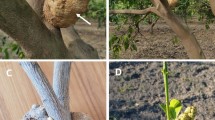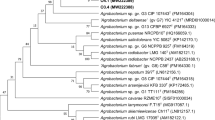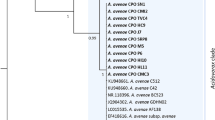Abstract
The aim of this study was to isolate, identify and analyze the diversity of the causative agents of crown galls and hairy roots from symptomatic plants of Vaccinium corymbossum by means of biological, biochemical and molecular tools. All the bacteria isolated from blueberries (n = 78) were found to be Agrobacterium since they grew on three differential media, provoked cell and/or root proliferation on Kalanchoe, and contained a 730 bp partial sequence that codes for virulence genes within the virC operon found on Ti and/or Ri plasmids. Isolates were highly variable considering the ERIC-PCR patterns as well as biochemical reactions and were all represented by 7 different restriction patterns of the 16SrDNA. While most of the isolates belonged to Agrobacterium bv. 1 (n = 33) or Agrobacterium bv. 2 (n = 31) only fourteen were Agrobacterium rubi. A representative isolate of each of these three groups was further identified by sequencing the approximately 400 bp 16SrDNA. We concluded that Vaccinium plants are particularly susceptible to Agrobacterium bv. 1, Agrobacterium bv. 2, and also to Agrobacterium rubi. To our knowledge this is the first survey of Agrobacterium affecting blueberries in Argentina.




Similar content being viewed by others
References
Alippi, A. M., Dal Bo, E., Ronco, L. B., López, M. V., López, A. C., & Aguilar, O. M. (2003). Pseudomonas populations causing pith necrosis of tomato and pepper in Argentina are highly diverse. Plant Pathology, 52, 287–302.
Alippi, A. M., López, A. C., & Balatti, P. A. (2010). First report of Agrobacterium rubi and Agrobacterium rhizogenes, causing crown and root gall and hairy root on blueberry in Argentina. Plant Disease, 94, 1064.
Anderson, A. R., & Moore, L. W. (1979). Host specificity in the genus Agrobacterium. Phytopathology, 69, 320–323.
Bautista-Zapanta, J.-N., Arafat, H. H., Tanaka, K., Sawada, H., & Suzuki, K. (2009). Variation of 16 S-23 S internally transcribed spacer sequence and intervening sequence in rDNA among the three major Agrobacterium species. Microbiology Research, 164, 604–612.
Benjama, A., Boubaker, H., Khlief, Z., Krimi, Z., Nesme, X., López, M. M., & Zoina, A. (2002). Susceptibility of stone-fruit rootstocks, rose and grapevine to Agrobacterium radiobacter var. tumefaciens in Arab Mediterranean countries. OEPP/EPPO Bulletin, 32, 463.
Bouzar, H., & Jones, J. B. (2001). Agrobacterium larrymoorei sp. nov., a pathogen isolated from aerial tumors of Ficus benjama. International Journal of Systematics and Evolutionary Microbiology, 51, 1023–1026.
Bouzar, H., Ouadah, D., Krimi, Z., Jones, J. B., Trovato, M., Petit, A., & Dessaux, Y. (1993). Correlative association between resident plasmids and the host chromosome in a diverse Agrobacterium Soil Population. Applied and Environmental Microbiology, 59, 1310–1317.
Costechareyre, D., Rhouma, A., Lavire, C., Portier, P., Chapulliot, D., Bertolla, F., Boubaker, A., Dessaux, Y., & Nesme, X. (2010). Rapid and efficient identification of Agrobacterium species by recA allele analysis. Microbial Ecology, 60, 862–872.
Dion, P., Belanger, C., Marquis, C., Ream, W., & Gelvin, S. B. (1996). Ecological significance of avirulence in Agrobacterium. In W. Reamand & S. B. Gelvin (Eds.), Crown Gall advances in understanding interkingdom gene transfer (pp. 44–58). St Paul: APS Press.
Farrand, S. K., van Berkum, P., & Oger, P. (2003). Agrobacterium is a definable genus of the family Rhizobiaceae. International Journal of Systematics and Evolutionary Microbiology, 53, 1681–1687.
Felsenstein, J. (1985). Confidence limits on phylogenies: an approach using bootstrap. Evolution, 39, 783–791.
Gelvin, S. B. (2010). Agrobacterium and plant genes involved in T-DNA transfer and integration. Annual Review of Plant Physiology and Plant Molecular Biology, 51, 223–256.
Goodner, B., Hinkle, G., Gattung, S., Miller, N., Blanchard, M., Qurollo, B., Goldman, B. S., Cao, Y., Askenazi, M., Halling, C., Mullin, L., Houmiel, K., Gordon, J., Vaudin, M., Iartchouk, O., Epp, A., Liu, F., Wollam, C., Allinger, M., Doughty, D., Scott, C., Lappas, C., Markelz, B., Flanagan, C., Crowell, C., Gurson, J., Lomo, C., Sear, C., Strub, G., Chris Cielo, C., & Slater, S. (2001). Genome sequence of the plant pathogen and biotechnology agent Agrobacterium tumefaciens C58. Science, 294, 2323–2328.
Holmes, B., & Roberts, P. (1981). The classification, identification and nomenclature of agrobacteria. Journal of Applied Bacteriology, 50, 443–467.
Kado, C. I. (1991). Molecular mechanisms of crown gall tumorogenesis. Critical Reviews in Plant Sciences, 10, 1–32.
Kechris, K. J., Lin, J. C., Bickel, P. J., & Glazer, A. N. (2006). Quantitative exploration of the occurrence of lateral gene transfer by using nitrogen fixation genes as a case study. Proceedings of the National Academy of Sciences, 103, 9584–9589.
Lasalle, F., Campillo, T., Vial, L., Baude, J., Costechareyre, D., Chapulliot, D., Shams, M., Abrouk, D., Lavire, C., Oger-Desfeux, C., Hommais, F., Guéguen, L., Daubin, V., Muller, D., & Nesme, X. (2011). Genomic species are ecological species as revealed by comparative genomics in Agrobacterium tumefaciens. Genome Biology and Evolution, 3, 762–781.
Lim, S. H., Kim, J. G., & Kang, H. W. (2009). Novel scar primers for specific and sensitive detection of Agrobacterium vitis strains. Microbiology Research, 164, 461–463.
Llop, P., Murillo, J., Lastra, B., & Lopez, M. M. (2009). Recovery of nonpathogenic mutant bacteria from tumors caused by several Agrobacterium tumefaciens strains: a frequent event? Applied and Environmental Microbiology, 75, 6504–6514.
López, A. C., & Alippi, A. M. (2007). Phenotypic and genotypic diversity of Bacillus cereus isolates recovered from honey. International Journal of Food Microbiology, 117, 175–184.
Minnemeyer, S. L., Lightfoot, R., & Matthysse, A. G. (2006). A semiquantitative bioassay for relative virulence of Agrobacterium tumefaciens strains on Bryophyllum daigremontiana. Journal of Bacteriology, 173, 7723–7724.
Moore, L. W., Bouzard, H., & Burr, T. (2001). Agrobacterium. In N. W. Schaad, J. B. Jones, & W. Chun (Eds.), Laboratory guide for the identification of plant pathogenic bacteria (pp. 17–35). St. Paul: APS Press.
Mougel, C., Cournoyer, B., & Nesme, X. (2001). Novel tellurite-amended media and specific chromosomal and Ti plasmid probes for direct analysis of soil populations of Agrobacterium biovars 1 and 2. Applied and Environmental Microbiology, 67, 65–74.
Nesme, X., Michel, M.-F., & Digat, B. (1987). Population heterogeneity of Agrobacterium tumefaciens in galls of Populus L. from a single nursery. Applied and Environmental Microbiology, 53, 655–659.
Panday, D., Schumann, P., & Das, S. K. (2011). Rhizobium pusense sp. nov., isolated from the rhizosphere of chickpea (Cicer arietinum L.). International Journal of Systematic and Evolutionary Microbiology, 61, 2632–2639.
Peluso, R., Raio, A., Morra, F., & Zoina, A. (2003). Physiological, biochemical and molecular analyses of an Italian collection of Agrobacterium tumefaciens strains. European Journal of Plant Pathology, 109, 291–300.
Perry, K. L., & Kado, C. I. (1982). Characteristics of Ti plasmids from broad-host range and ecologically specific biotype 2 and 3 strains for Agrobacterium tumefaciens. Journal of Bacteriology, 151, 343–350.
Portier, P., Le Saux, M. F., Mougel, C., Lerondelle, C., Chapulliot, D., Thiolouse, J., & Nesme, X. (2006). Identification of genomic species in Agrobacterium biovar 1 by AFLP genomic markers. Applied and Environmental Microbiology, 72, 7123–7131.
Pulawska, J., Willems, A., & Sobiczewski, P. (2006). Rapid and specific identification of four Agrobacterium species and biovars using multiplex PCR. Systematic and Applied Microbiology, 29, 470–479.
Pulawska, J., Willems, A., & Sobiczewski, P. (2012). Rhizobium skierniewicense sp. nov. isolated from tumors on chrysanthemum and Prunus in Poland. International Journal of Systematic and Evolutionary Microbiology, 62, 895–899.
Ryder, M. H., Tate, M. E., & Kerr, A. (1985). Virulence properties of strains of Agrobacterium on the apical and basal surfaces of carrot root discs. Plant Physiology, 77, 215–221.
Sanger, F., Nicklen, S., & Coulson, A. R. (1977). DNA sequencing with chain terminating inhibitors. Proceedings of the National Academy of Sciences USA, 74, 5463–5467.
Sawada, H., Leki, H., & Matsuda, I. (1995). PCR detection of Ti and Ri plasmids for phytopathogenic Agrobacterium strains. Applied and Environmental Microbiology, 61, 828–831.
Slater, S. C., Goldman, B. S., Goodner, B., Setubal, J. C., Farrand, S. K., Nester, E. W., Burr, T. J., Banta, L., Dickerman, A. W., Paulsen, I., Otten, L., Suen, G., Welch, R., Almeida, N. F., Arnold, F., Burton, Zijin Du, Z., Ewing, A., Godsy, E., Heisel, S., Houmiel, K. L., Jhaveri, J., Lu, J., Miller, N. M., Norton, S., Chen, Q., Phoolcharoen, W., Ohlin, V., Ondrusek, D., Pride, N., Stricklin, S. L., Sun, J., Wheeler, C., Wilson, L., Zhu, H., & Wood, D. W. (2009). Genome sequences of three Agrobacterium biovars help elucidate the evolution of multichromosome genomes in bacteria. Journal of Bacteriology, 191, 2501–2511.
Tighe, S. W., de Lajudie, P., Dipietro, K., Lindström, K., Nick, G., & Jarvis, B. D. W. (2000). Analysis of cellular fatty acids and phenotypic relationships of Agrobacterium, Bradyrhizobium, Mesorhizobium, Rhizobium and Sinorhizobium species using the Sherlock microbial identification system. International Journal of Systematics and Evolutionary Microbiology, 50, 787–801.
Velázquez, E., Palomo, J. L., Rivas, R., Guerra, H., Peix, A., Trujillo, M. E., García-Benavídez, P., Mateos, P. F., Wabico, H., & Martínez Molina, E. (2010). Analysis of core genes supports the reclassification of strains Agrobacterium radiobacter K84 and Agrobacterium tumefaciens AKE10 into the species Rhizobium rhizogenes. Systematics and Applied Microbiology, 33, 247–251.
Versalovic, J., Schneider, M., de Bruijn, F. J., & Lupski, J. R. (1994). Genomic fingerprinting of bacteria using repetitive sequence-based polymerase chain reaction. Methods in Molecular and Cellular Biology, 5, 25–40.
Vincent, J. M. (1970). A manual for the practical study of root-nodule bacteria. Oxford: Blackwell.
Weisburg, W. G., Barns, S. M., Pelletier, D. A., & Lane, D. J. (1991). 16 S ribosomal DNA amplification for phylogenetic study. Journal of Bacteriology, 173, 697–703.
Young, J. M., Kuykendall, L. D., Martínez-Romero, E., Kerr, A., & Sawada, H. (2001). A revision of Rhizobium Frank 1889, with an emended description of the genus, and the inclusion of all species of Agrobacterium Conn 1942 and Allorhizobium undicola de Lajudie et al. 1998 as new combinations: Rhizobium radiobacter, R. rhizogenes, R. rubi, R. undicola and R. vitis. International Journal of Systematics and Evolutionary Microbiology, 51, 89–103.
Young, J. M., Park, D., & Weir, B. S. (2004). Diversity of 16S rDNA sequences of Rhizobium spp. implications for species determinations. FEMS Microbiology Letters, 238, 125–131.
Young, J. M., Kerr, A., & Sawada, H. (2005). Genus II. Agrobacterium. In G. M. Garrity, D. J. Brenner, N. R. Krieg, & J. R. Staley (Eds.), Bergey’s manual of systematic bacteriology, volume two: The Proteobacteria, parts A - C (pp. 340–345). Athens: Springer – Verlag.
Acknowledgments
A.M.A and P.B.A. are members of the Scientific Research Career of Comisión de Investigaciones Científicas de la Provincia de Buenos Aires (CIC) (Argentina) and A.C.L. is a Member of CONICET (CCT La Plata). This research was supported by a grant from CIC. The authors are grateful Drs. D. H. Grasso (Instituto de suelos, INTA Castelar, Argentina) and S. Süle (Plant Protection Institute, Hungarian Academy of Sciences, Budapest, Hungary) for providing the reference strains A. tumefaciens LBA 956 and A. vitis K306 and S4 respectively.
Author information
Authors and Affiliations
Corresponding author
Rights and permissions
About this article
Cite this article
Alippi, A.M., López, A.C. & Balatti, P.A. Diversity among agrobacteria isolated from diseased plants of blueberry (Vaccinium corymbosum) in Argentina. Eur J Plant Pathol 134, 415–430 (2012). https://doi.org/10.1007/s10658-012-0001-x
Accepted:
Published:
Issue Date:
DOI: https://doi.org/10.1007/s10658-012-0001-x




